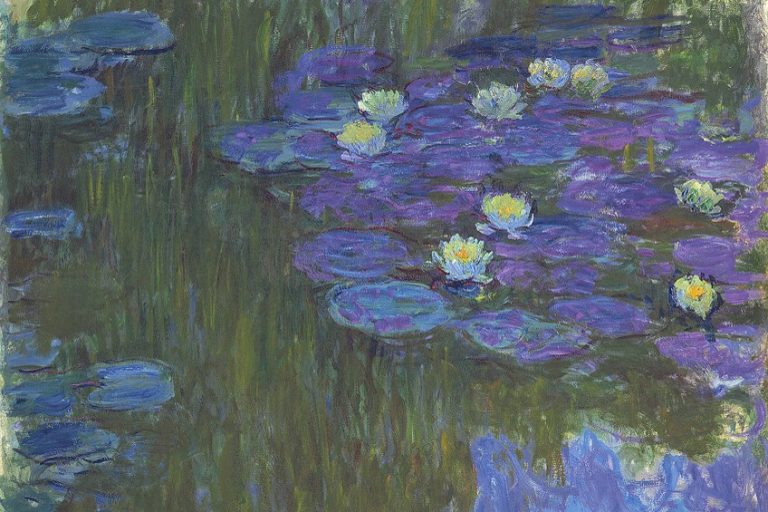Seascape Paintings by Claude Monet – 11 Maritime Masterpieces
Claude Monet, a pioneer of Impressionism, is renowned for his breathtaking seascape paintings that capture the essence of the sea in its various moods and atmospheres. With a masterful use of light, color, and brushstrokes, Monet’s seascapes transport viewers to coastal scenes filled with movement, tranquility, and dynamic beauty. From the shimmering reflections on water to the dramatic interplay of sky and sea, Monet’s seascapes are not just artistic renderings but immersive experiences that evoke a deep connection with nature’s ever-changing elements. In this article, we delve into some of Monet’s most famous seascape paintings, exploring their artistic techniques, themes, and enduring impact on the world of art.
Monet and the Sea
Claude Monet, renowned for his mastery of capturing light and atmosphere, had a profound and evolving relationship with the sea in his artworks. Initially drawn to coastal scenes for their vibrant colors and dynamic play of light, Monet’s early seascapes depict the sea with a sense of awe and wonder. His paintings from the Normandy coast showcase his fascination with the ever-changing nature of the sea, from calm waters reflecting the sky to tumultuous waves crashing against the shore. As Monet’s career progressed, his approach to seascapes became more experimental.
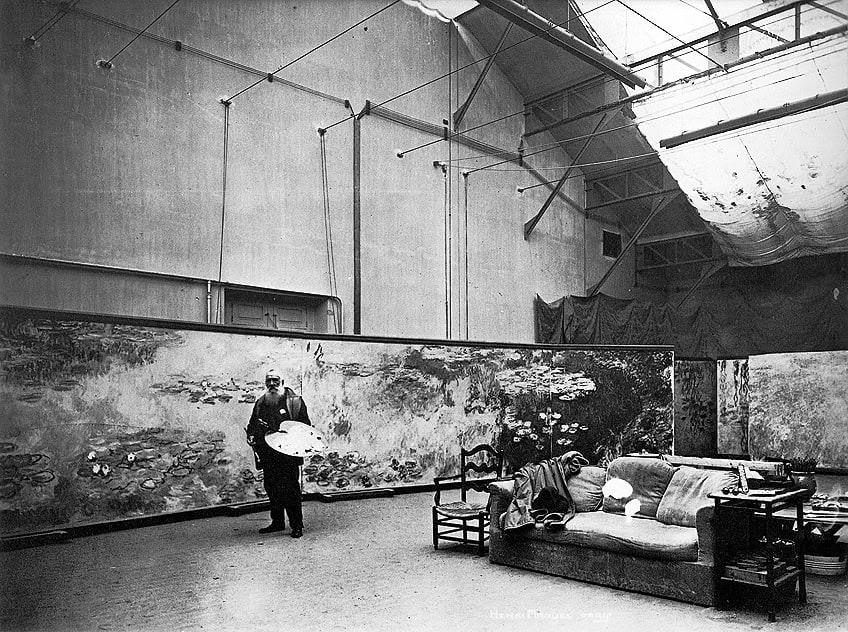
He ventured to different coastal regions, including the rugged cliffs of Étretat and the picturesque harbors of Antibes and Venice. In these works, Monet explored the sea’s textures and the interplay between water, light, and atmosphere with increasing depth and nuance.
One of Monet’s most famous series, the Water Lilies paintings, also reflects his deep connection to water.
Although not depicting the sea directly, these monumental works capture the essence of water’s movement, tranquility, and reflective qualities, inviting viewers to immerse themselves in a contemplative experience akin to gazing at the sea’s vastness. Overall, Monet’s relationship with the sea in his artworks evolved from awe-inspired observations to a nuanced exploration of water’s visual and emotional richness, leaving an enduring legacy in the realm of seascape painting.
Top 11 Most Famous Seascape Paintings by Claude Monet
Discover the captivating allure of Monet’s top seascape works, where the artist’s mastery of light, color, and movement comes to life on canvas. Through Monet’s brushstrokes, the sea becomes a dynamic symphony of shimmering blues and greens, capturing the ever-changing essence of the ocean’s mood and atmosphere. Each painting invites you to immerse yourself in serene coastal scenes, where waves dance with sunlight and shores beckon with tranquil beauty.
Join us on a journey through Monet’s seascape masterpieces, where nature’s grandeur meets the artist’s vision in a breathtaking fusion of art and emotion.
The Seine Estuary at Honfleur (1865)
| Date | 1865 |
| Medium | Oil on canvas |
| Dimensions (cm) | 89.5 x 150.5 |
| Where Is It Housed? | The Norton Simon Museum, California, United States |
The Seine Estuary at Honfleur by Monet is a tranquil portrayal of the Honfleur coastline, where the sea takes on a dual role. On one hand, it serves as a reflective surface, mirroring the sky and enhancing the sense of depth in the painting. On the other hand, the sea symbolizes continuity and timelessness, connecting the land and the horizon in a seamless blend of earth and water.
Monet’s use of soft, natural tones in the sea creates a harmonious atmosphere, inviting viewers to contemplate the peaceful coexistence of natural elements.
The Port of Sainte-Adresse (1867)
| Date | 1867 |
| Medium | Oil on canvas |
| Dimensions (cm) | 75 x 105 |
| Where Is It Housed? | The Metropolitan Museum of Art, New York City, United States |
The Port of Sainte-Adresse captures Monet’s fascination with maritime life and coastal scenes. The sea here acts as a dynamic backdrop, showcasing the bustling activity of boats in the harbor. Its presence adds a sense of movement and energy to the composition, contrasting with the stillness of the boats and buildings in the foreground. Through his masterful use of light and color, Monet infuses the sea with a sense of life and vitality, reinforcing its role as a vital element in the coastal community.
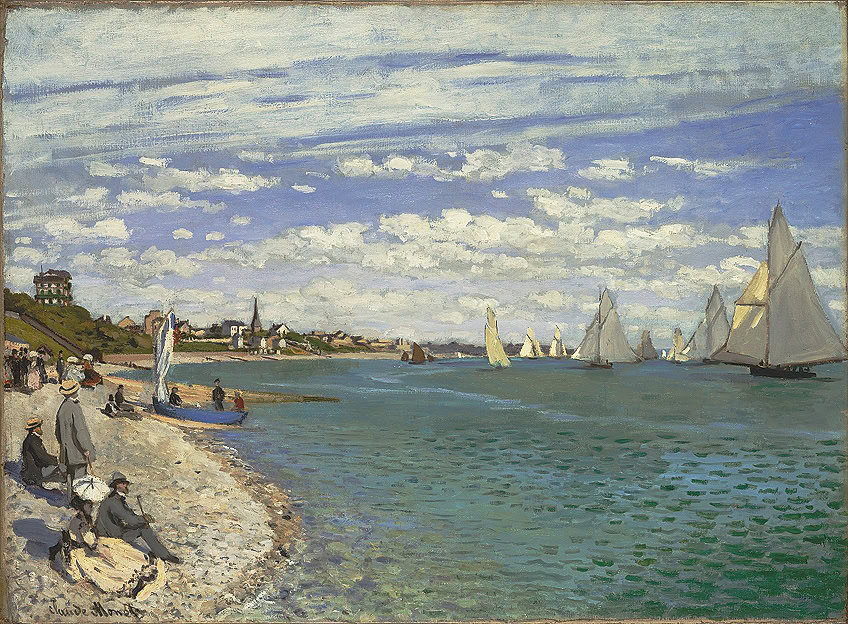
Garden at Sainte-Adresse (1867)
| Date | 1867 |
| Medium | Oil on canvas |
| Dimensions (cm) | 98.1 x 129.9 |
| Where Is It Housed? | The Metropolitan Museum of Art, New York City, United States |
In Garden at Sainte-Adresse, Monet combines the tranquility of a garden setting with the expansive beauty of the sea. Here, the sea serves as a visual anchor, stretching beyond the garden’s confines and merging with the distant horizon. Its presence lends a sense of vastness and freedom to the scene, enhancing the contrast between the intimate, enclosed space of the garden and the boundless expanse of the sea.
Monet’s careful attention to detail in capturing the play of light on water further emphasizes the sea’s importance as a natural force that shapes the environment.
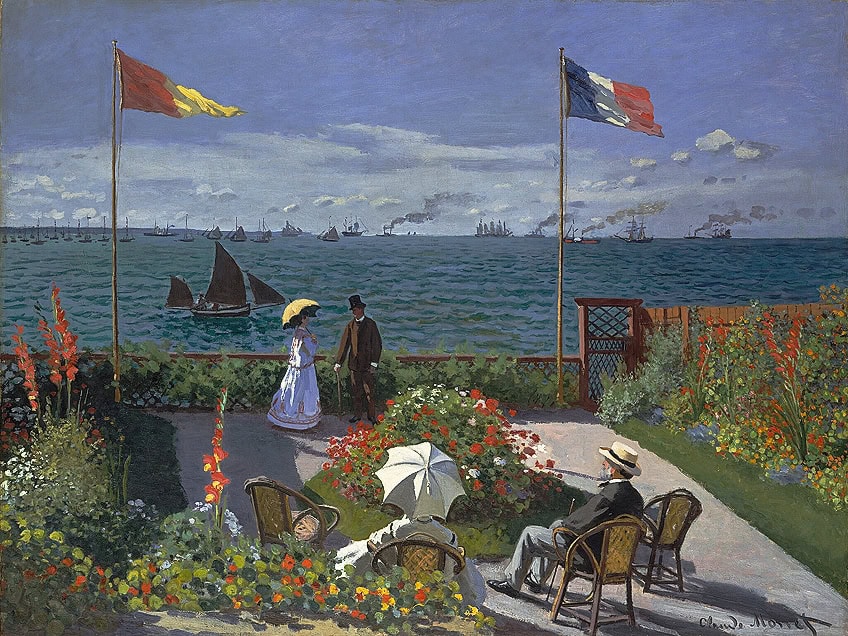
The Beach at Trouville (1870)
| Date | 1870 |
| Medium | Oil on canvas |
| Dimensions (cm) | 38.7 x 46.5 |
| Where Is It Housed? | The National Gallery, London, United Kingdom |
The Beach at Trouville portrays a lively coastal scene teeming with human activity against the backdrop of the sea. Here, the sea takes on a symbolic role, representing leisure, recreation, and the timeless appeal of seaside destinations. Monet’s depiction of waves gently lapping against the shore and distant sailboats evokes a sense of relaxation and enjoyment associated with beach outings. The sea becomes a central element in the narrative of leisure and pleasure, drawing viewers into the vibrant atmosphere of a coastal retreat.
Impression, Sunrise (1872)
| Date | 1872 |
| Medium | Oil on canvas |
| Dimensions | 48 × 63 |
| Where Is It Housed? | Musée Marmottan Monet, Paris, France |
Impression, Sunrise is a groundbreaking work that epitomizes Monet’s exploration of light, atmosphere, and the fleeting nature of perception. The sea in this painting serves as a canvas for the interplay of light and color, capturing the ephemeral qualities of dawn. As the sun rises over the horizon, casting a soft glow on the water, the sea becomes a metaphor for the passage of time and the transience of natural phenomena.
Monet’s bold brushwork and expressive use of color convey the sea’s ever-changing character, inviting viewers to contemplate the beauty of fleeting moments in nature.

The Cliff Walk at Pourville (1882)
| Date | 1882 |
| Medium | Oil on canvas |
| Dimensions | 66.5 × 82.3 |
| Where Is It Housed? | Art Institute of Chicago, Illinois, United States |
The Cliff Walk at Pourville encapsulates Monet’s fascination with capturing the interplay of light and movement in coastal settings. The sea in this painting serves as a dynamic element, contrasting the stability of the cliffs with its ever-changing waves. It symbolizes the eternal cycle of nature, where the sea’s constant motion shapes the landscape over time, creating a scene that is both tranquil and powerful.

Boats on the Beach at Étretat (1883)
| Date | 1883 |
| Medium | Oil on canvas |
| Dimensions | 66 × 82.3 |
| Where Is It Housed? | Art Institute of Chicago, Illinois, United States |
Boats on the Beach at Étretat presents a scene of quietude and reflection, where boats find respite in the calm waters near Étretat. The sea in this artwork embodies a sense of tranquility and stability, providing a peaceful backdrop for the resting boats.
Monet’s careful attention to detail in depicting the sea’s surface reflects his keen observation of light and its effects on water, enhancing the overall serenity of the composition.

The Stormy Sea at Étretat (1883)
| Date | 1883 |
| Medium | Oil on canvas |
| Dimensions | 60.3 × 81 |
| Where Is It Housed? | The Museum of Fine Arts of Lyon, Lyon, France |
The Stormy Sea at Étretat captures the dramatic beauty of Étretat’s cliffs and the relentless energy of the sea. Here, the sea symbolizes both a force of nature and a source of inspiration for Monet. Its crashing waves against the rocky shore evoke a sense of power and grandeur, highlighting the rugged yet captivating character of coastal environments.
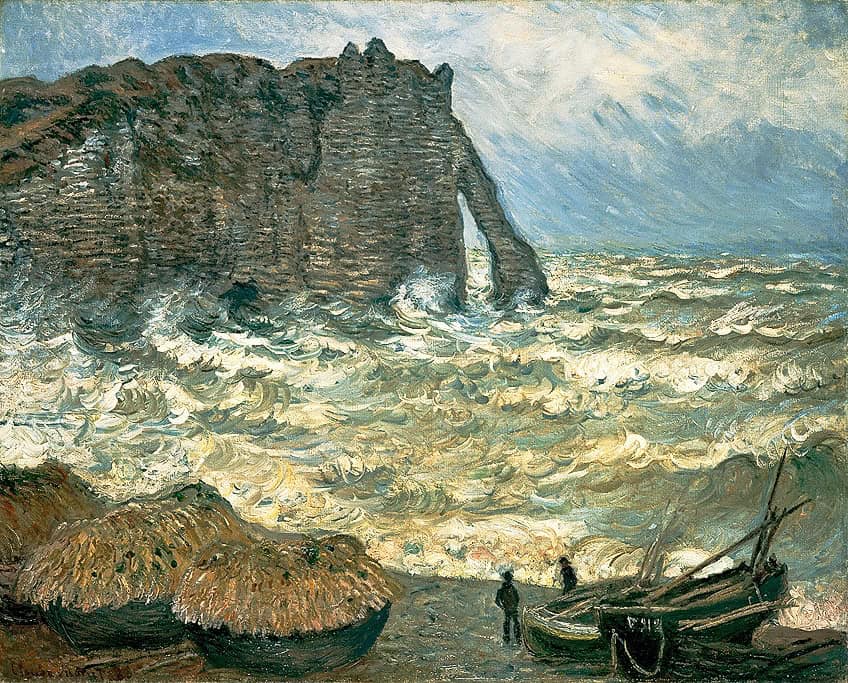
Fishing Boats at Étretat (1885)
| Date | 1885 |
| Medium | Oil on canvas |
| Dimensions | 65 × 92 |
| Where Is It Housed? | Seattle Art Museum, Washington State, United States |
Fishing Boats at Étretat immerses viewers in the bustling activity of a fishing community, where boats and fishermen coexist harmoniously with the sea. The sea in this painting represents a livelihood and a connection to the natural world, as fishermen depend on its bounty for sustenance. Monet’s skillful use of color and composition captures the vibrancy of daily life by the sea, inviting viewers to appreciate the symbiotic relationship between humans and the marine environment.

Rocks at Belle-Île, Port-Domois (1886)
| Date | 1886 |
| Medium | Oil on canvas |
| Dimensions (cm) | 60 x 100 |
| Where Is It Housed? | Musée d’Orsay, Paris, France |
Rocks at Belle-Île, Port-Domois showcases Monet’s ability to convey the rugged beauty of coastal formations. The sea in this artwork symbolizes resilience and endurance, as the rocky shoreline withstands the relentless forces of erosion.
Monet’s expressive brushwork and bold colors bring the rocky landscape to life, emphasizing the dynamic tension between solid rock and fluid water.

Morning on the Seine, near Giverny (1896)
| Date | 1897 |
| Medium | Oil on canvas |
| Dimensions (cm) | 81.3 x 64.8 |
| Where Is It Housed? | Museum of Fine Arts, Boston, United States |
Morning on the Seine, near Giverny shifts Monet’s focus to the tranquil waters of the Seine River, where the sea’s influence extends inland. The sea (represented by the river) here embodies a sense of calmness and continuity, as it flows steadily through the landscape. Monet’s mastery of atmospheric effects and subtle nuances of light captures the serene beauty of the river at daybreak, evoking a sense of harmony and introspection.

Monet’s famous seascape paintings capture the essence of the sea in its various moods and colors. Through his mastery of light, color, and brushwork, Monet brings to life the dynamic and ever-changing nature of the ocean. From the tranquil scenes of boats at rest to the powerful waves crashing against the shore, Monet’s seascapes not only showcase his technical skill but also evoke a sense of awe and admiration for the beauty of nature. His innovative use of color and light continues to inspire artists and art enthusiasts alike, making his seascape paintings timeless masterpieces in the world of art history.
Frequently Asked Questions
What Inspired Claude Monet to Paint Seascape Paintings?
Monet’s love for the sea was sparked during his visits to coastal regions like Normandy and Brittany. The ever-changing light, colors, and moods of the sea captivated his artistic sensibilities, leading to a lifelong exploration of seascape themes.
How Did Monet Capture the Essence of the Sea in His Paintings?
Monet’s innovative use of color and light allowed him to depict the sea’s dynamic nature. He often painted en plein air, directly observing and capturing the sea’s reflections, ripples, and atmospheric effects, creating a sense of movement and life in his works.
Which Seascape Painting by Monet Is Considered Iconic?
Impression, Sunrise (1872) is one of Monet’s most famous seascape paintings. It not only gave rise to the Impressionist movement but also exemplifies Monet’s mastery in depicting the sea’s mood through vibrant colors and loose brushstrokes.
What Techniques Did Monet Use to Portray the Sea’s Shimmering Surface?
Monet’s use of broken color and short brushstrokes, known as dabs, created an optical mixing effect that mimicked the sparkling and reflective nature of the sea’s surface. This technique, called Pointillism or Divisionism, added depth and luminosity to his seascape compositions.
Isabella studied at the University of Cape Town in South Africa and graduated with a Bachelor of Arts majoring in English Literature & Language and Psychology. Throughout her undergraduate years, she took Art History as an additional subject and absolutely loved it. Building on from her art history knowledge that began in high school, art has always been a particular area of fascination for her. From learning about artworks previously unknown to her, or sharpening her existing understanding of specific works, the ability to continue learning within this interesting sphere excites her greatly.
Her focal points of interest in art history encompass profiling specific artists and art movements, as it is these areas where she is able to really dig deep into the rich narrative of the art world. Additionally, she particularly enjoys exploring the different artistic styles of the 20th century, as well as the important impact that female artists have had on the development of art history.
Learn more about Isabella Meyer and the Art in Context Team.
Cite this Article
Isabella, Meyer, “Seascape Paintings by Claude Monet – 11 Maritime Masterpieces.” Art in Context. May 22, 2024. URL: https://artincontext.org/seascape-paintings-by-claude-monet/
Meyer, I. (2024, 22 May). Seascape Paintings by Claude Monet – 11 Maritime Masterpieces. Art in Context. https://artincontext.org/seascape-paintings-by-claude-monet/
Meyer, Isabella. “Seascape Paintings by Claude Monet – 11 Maritime Masterpieces.” Art in Context, May 22, 2024. https://artincontext.org/seascape-paintings-by-claude-monet/.





